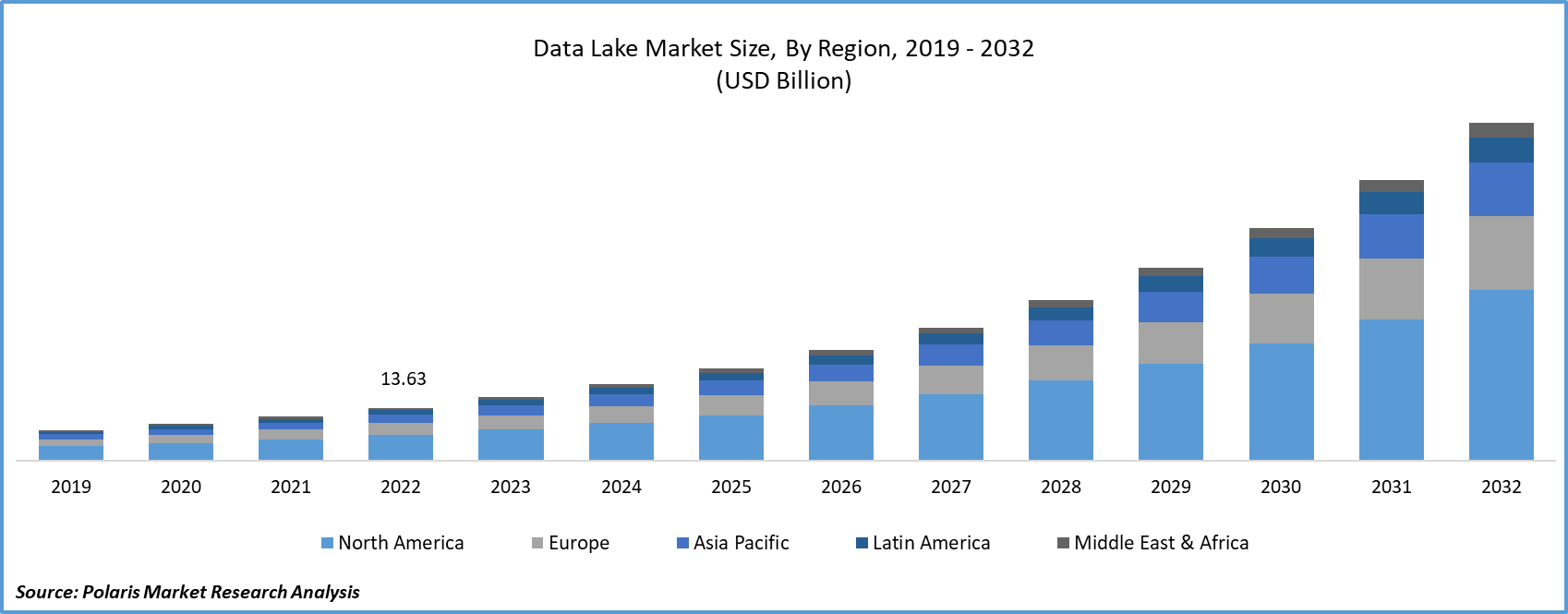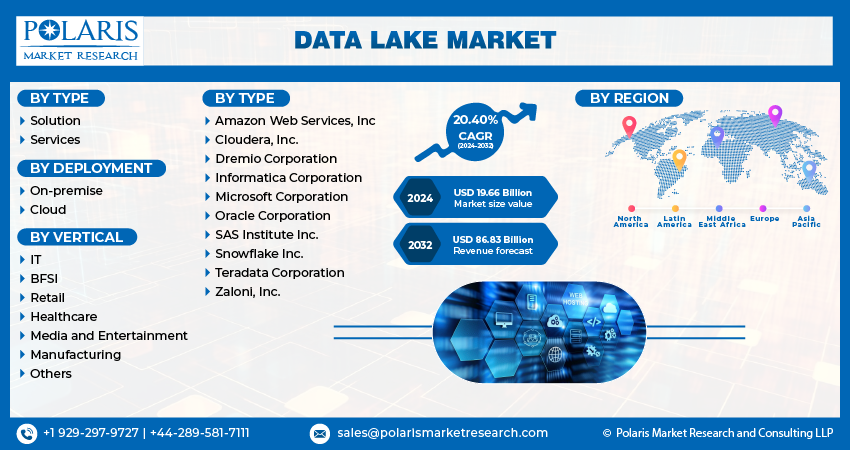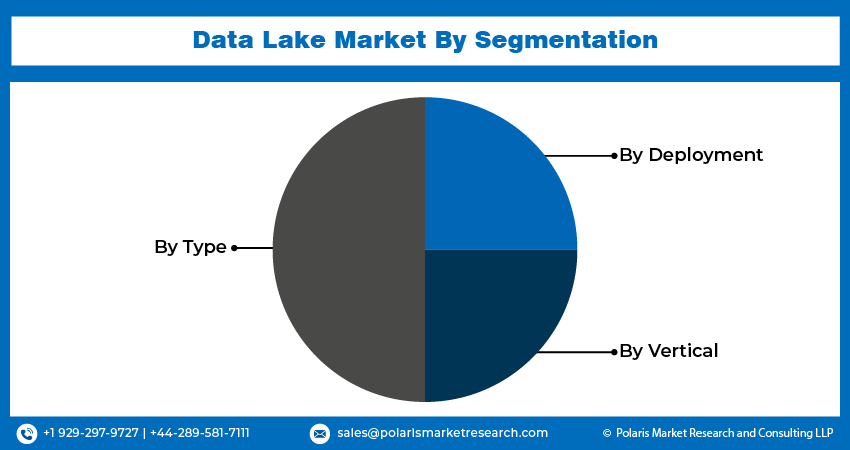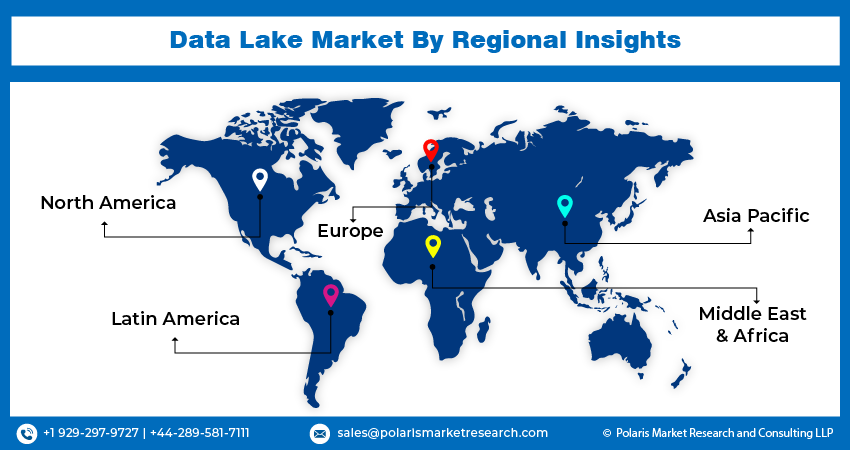
Data Lake Market Share, Size, Trends, Industry Analysis Report, By Type (Solution, Services), By Deployment (Cloud, On-premise), By Vertical (IT, BFSI, Retail, Healthcare), By Region, And Segment Forecasts, 2024-2032
- Published Date:Jan-2024
- Pages: 116
- Format: PDF
- Report ID: PM3867
- Base Year: 2023
- Historical Data: 2019-2022
Report Outlook
The global data lake market was valued at USD 16.37 billion in 2023 and is expected to grow at a CAGR of 20.40% during the forecast period.
Vast volumes of data are generated on digital platforms every day, creating a substantial need for effective storage solutions. In this context, data lakes serve as specialized systems designed to house information in its unprocessed state. Essentially acting as central repositories, data lakes provide a streamlined approach to managing extensive amounts of data that can be readily accessed. Within a data lake, the stored information may encompass unstructured data, which holds particular significance for data analysts and scientists. Additionally, structured data, a prevalent format utilized by industries such as aviation and automotive, finds its place within these repositories. Overall, data lakes play a pivotal role in accommodating and organizing the diverse forms of data that modern information ecosystems generate.

To Understand More About this Research: Request a Free Sample Report
The anticipated increase in the adoption of Internet of Things (IoT) devices is poised to exert a favorable influence on data lake market expansion. The surge in data volume, concurrent with the expanding use of IoT, is projected to propel the growth of the market. Furthermore, positive market impacts can be attributed to diverse governmental endeavors, including the creation of smart urban centers and the deployment of intelligent utility meters.
The surge in digital payments has led to a proliferation of transactional data within banks on a global scale. Many financial institutions are allocating resources toward the establishment of data lakes to enhance their analytical capabilities and deliver seamless solutions to their clientele. Notably, banks like Australia and New Zealand Banking Group and State Bank of India have initiated the development of data lakes to seamlessly integrate transactional data spanning various sectors and establish a unified database. As a result, data lakes enable banks to consolidate transactional data from disparate data sources into a centralized repository accessible to individuals in real time.

Industry Dynamics
Growth Drivers
Rising adoption of data lakes drives the market
Data lakes offer businesses a means to augment their capabilities through a range of advantages, encompassing comprehensive integration of various data sources, seamless scalability, rapid ingestion of data at elevated velocities, heightened adaptability, and eradication of data silos. Moreover, enterprises stand to gain a competitive edge by swiftly extracting heightened value from the stored data. The utilization of data lakes equips enterprises with dynamic and advanced capabilities for data analytics. An additional advantage lies in the cost-effectiveness of implementing data lakes compared to the expenses associated with setting up traditional data warehouses. As a result, the adoption of data lakes is poised to increase significantly over the projected timeframe.
Report Segmentation
The market is primarily segmented based on type, deployment, vertical, and region.
|
By Type |
By Deployment |
By Vertical |
By Region |
|
|
|
|
To Understand the Scope of this Report: Speak to Analyst
By Type Analysis
Solutions segment accounted for the largest market share in 2022
The solutions segment accounted for the largest market share. This is primarily due to the growing utilization of data lakes across industries such as IT, BFSI, and retail. Data lake solutions play a pivotal role in enabling IT operations to analyze both structured and unstructured data, extracting valuable insights. Furthermore, numerous companies are adopting data solutions to optimize and assess their internal workflows.
The services segment will grow at a steady pace. This is attributed to the growing emphasis of major industry players on introducing data lake services with broader availability. For example, in August 2019, Amazon Web Services, Inc. (AWS) unveiled the general availability of its fully managed offering known as 'AWS Lake Formation.' This service streamlines the process of establishing a secure data lake efficiently.
By Vertical Analysis
Retail segment held the significant market share in 2022
The retail segment held the majority market share. Within retail marketing, the utilization of data lakes could prove pivotal, facilitating swift identification and categorization of potential customers. Leveraging data lakes, retailers can achieve an in-depth comprehension of buyers, their purchasing motivations, and their preferences. This insight is gleaned through the analysis of information aggregated from diverse sources, encompassing call logs, surveys, and social media platforms. Whereas IT segment will grow at a rapid pace. The adoption of data lakes in the IT domain plays a pivotal role in achieving a harmonious equilibrium between operational speed, cost efficiency, and information quality for IT companies.
By Deployment Analysis
On- Premise segment held the largest share
The on-premise segment dominated the market. This is largely due to the prevalent practice of companies maintaining their data centers and servers for efficient operational performance, making on-premise deployment a preferred choice. However, the landscape is evolving with the progress of technology and the increasing integration of cloud solutions across sectors like IT, BFSI, and Healthcare. This shift is anticipated to propel the growth of cloud deployment in the foreseeable future.
Moreover, prominent players within the data lake sphere provide cloud-based offerings designed to streamline equipment maintenance procedures and enhance profitability. The surge in cloud data lake adoption is attributed to the advantages it offers, encompassing flexibility, scalability, agility, and cost-efficiency. Organizations lean towards favoring cloud-based solutions due to their compatibility with cross-regional, regional, or cross-country data storage and retrieval strategies. Consequently, these solutions bolster enterprises in safeguarding stored data, particularly in the face of potential disasters.

Regional Insights
North America region dominated the global market in 2022
North America held the largest share. This prominence is attributed to the escalating volume of data across diverse industries, heightened investments in data lake infrastructure, and the growing adoption of big data technologies. Additionally, data lakes are poised to play a pivotal role in advancing healthcare analytics. To illustrate, in response to the COVID-19 pandemic outbreak, numerous companies embarked on the creation of transformative data-driven solutions to enhance decision-making processes. In March 2020, C3 ai, Inc., a U.S.-based AI company, introduced a COVID-19 data lake—a centralized repository that offers a unified and accessible dataset, available for public use.
APAC will grow at a steady pace. This growth trajectory is primarily attributed to the escalating investments orchestrated by prominent technology firms across key emerging nations. Additionally, the region is poised to benefit from various contributing factors, including the expanding trend of digitization and the increasing adoption of advanced big data analytics technology. Moreover, government initiatives and regulatory measures are pivotal drivers fostering market expansion within the region.

Key Market Players & Competitive Insights
The sector is witnessing an uptick in market consolidation, driven by strategic maneuvers such as mergers, collaborations, and acquisitions. Additionally, prominent players in the market are directing their efforts toward pioneering technological advancements.
Some of the major players operating in the global market include:
- Amazon Web Services, Inc
- Cloudera, Inc.
- Dremio Corporation
- Informatica Corporation
- Microsoft Corporation
- Oracle Corporation
- SAS Institute Inc.
- Snowflake Inc.
- Teradata Corporation
- Zaloni, Inc.
Recent Developments
- In May 2023, Amazon Web Services, Inc. unveiled Amazon Security Lake, a solution designed to automate the centralization of security data within organizations.
- In August 2022, Cloudera introduced Cloudera Data Platform (CDP), a SaaS offering that incorporates built-in security and machine learning (ML) capabilities to provide actionable insights.
- In July 2021, Dremio has unveiled the SQL Lakehouse Service, a solution designed to expedite business intelligence (BI) and analytics processes. This service facilitates organizations in utilizing an open data architecture and eliminates the need for duplicating data into proprietary data warehouses, significantly simplifying cloud data lakes management by a factor of 10.
- In June 2021, Cloudera revealed its acquisition of Datacoral and Cazena as part of its strategic efforts to broaden its presence in the hybrid cloud sector beyond big data. This move is intended to expedite Cloudera's strategic roadmap towards establishing a prominent position in the hybrid cloud landscape.
Data Lake Market Report Scope
|
Report Attributes |
Details |
|
Market size value in 2024 |
USD 19.66 billion |
|
Revenue forecast in 2032 |
USD 86.83 billion |
|
CAGR |
20.40% from 2024 – 2032 |
|
Base year |
2023 |
|
Historical data |
2019 – 2022 |
|
Forecast period |
2024 – 2032 |
|
Quantitative units |
Revenue in USD billion and CAGR from 2024 to 2032 |
|
Segments covered |
By Type, By Deployment, By Vertical, By Region |
|
Regional scope |
North America, Europe, Asia Pacific, Latin America; Middle East & Africa |
|
Customization |
Report customization as per your requirements with respect to countries, region and segmentation. |
